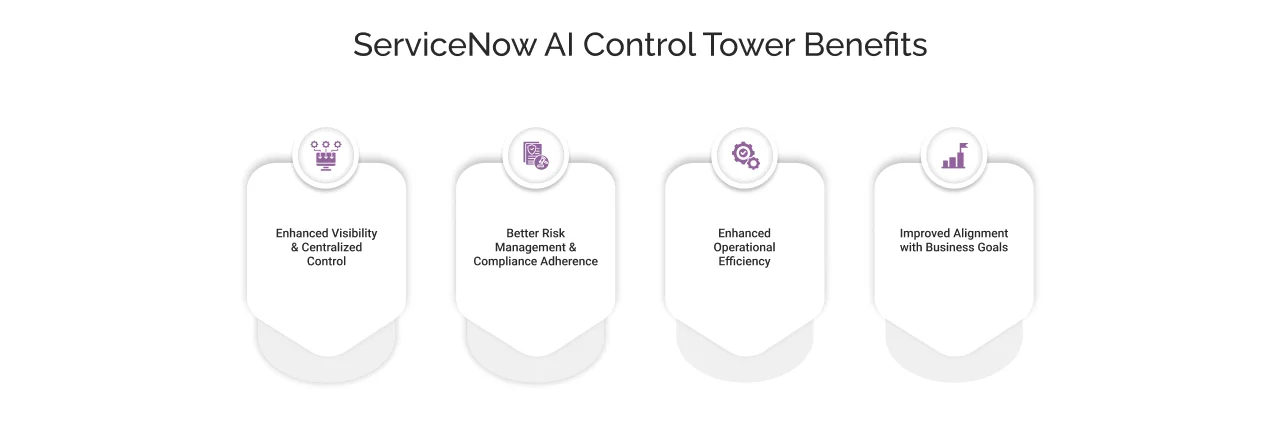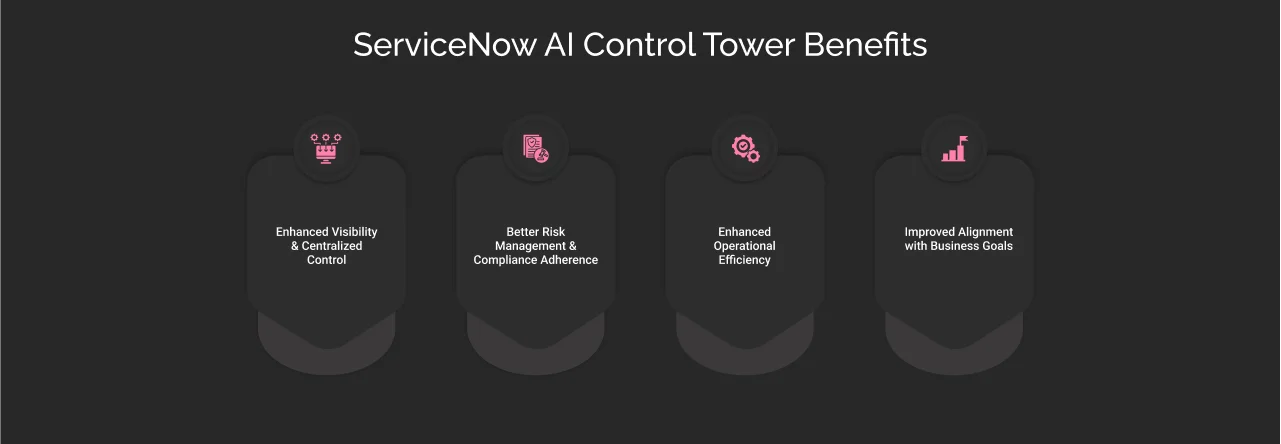ServiceNow AI Control Tower: Everything You Need to Know
Table of Contents
As AI quickly becomes part of many business operations, it leads to new ways to innovate and improve efficiency. However, this growth also introduces challenges, especially in managing different AI models and tools, like AI agents. It can be complicated to handle requests from various teams and departments wanting to use AI while ensuring compliance and success. Here, a centralized governance platform can make a significant difference.
According to a Gartner report, by 2028, companies that use AI governance platforms will have 30% higher customer trust ratings and 25% better compliance scores than their competitors.
This is where ServiceNow steps in with it’s AI Control Tower. It can be described as a centralized command center designed to provide comprehensive oversight and governance for all AI initiatives at the enterprise level. This platform is the latest addition to the suite of AI innovations unveiled at the ServiceNow Knowledge 2025 event.
In this blog, we will explore what the platform offers and more. Continue reading!
ServiceNow AI Control Tower: What It Is and Does?
In simple words, the AI Control Tower is a platform designed to connect various parts of an organization, facilitating faster adoption of artificial intelligence. It offers a unified system that enables organizations to effectively manage the entire lifecycle of their AI assets, from initial conception to ongoing monitoring and refinement. This streamlines processes and brings order and control to AI initiatives.
The platform helps businesses manage, secure, and measure their AI tools, such as AI agents, machine learning models, and automated workflows. It can work with not just the AI solutions from the ServiceNow ecosystem but also those from other third-party vendors. This means the control tower can integrate any AI solution with existing workflows without any issues.
Additionally, the platform ensures that AI systems proactively comply with company policies and global regulations, with a focus on privacy, data governance, and ethical AI. It enforces best practices in AI governance throughout the organization and provides specific support for key regulatory frameworks, including the NIST AI Risk Management Framework (RMF) and the European Union’s Artificial Intelligence (EU AI) Act.
Understanding the ServiceNow AI Control Tower Architecture
ServiceNow AI Control Tower operates on the robust foundation of the ServiceNow AI Platform, which serves as the unified cloud infrastructure for all ServiceNow products. A fundamental aspect of its operation is its ability to leverage ServiceNow’s unified data architecture, which provides the necessary business context to seamlessly connect AI initiatives with core business services and underlying technology infrastructure.
The Control Tower leverages the AI Inventory to govern, monitor, and optimize AI initiatives. The AI Inventory is a centralized repository within ServiceNow that catalogs and manages all AI-related assets across an organization. This includes:
- AI systems, models, and agents
- Datasets used for training or inference
- Prompts, tools, and workflows associated with AI operations
- Third-party AI components
This deep integration is then facilitated by the Configuration Management Database (CMDB) and the Common Services Data Model (CSDM), which play a crucial role in embedding AI into the very fabric of an organization’s business services and technological landscape. The CMDB acts as the system of record for all IT assets, including AI components, allowing AI Control Tower to discover and manage them effectively.
Furthermore, the AI Agent Fabric represents a significant architectural component, functioning as a communication backbone for the entire AI ecosystem. This fabric enables seamless collaboration and information exchange between ServiceNow AI agents, and third-party systems alike.
This promotes interoperability by supporting common communication protocols, such as the Agent2Agent (A2A) protocol and Model Context Protocol (MCP). This ensures that various AI systems can interact and coordinate effectively with different agents as well as other tools. It is essential to maintain harmony in the orchestration between these AI systems, particularly the agents, so that each agent remains aligned, coordinated, and optimized to deliver impactful results.
What are the Benefits of ServiceNow AI Control Tower?
Here are some of the most prominent advantages of AI Control Tower.


Enhanced Visibility and Centralized Control
The Control Tower provides a single, unified platform that offers unparalleled visibility into all AI initiatives unfolding across the organization. This allows a holistic view of AI agents in operation, understanding the tasks they are performing, and tracking their impact on business outcomes. This comprehensive view eventually helps organizations make informed decisions.
Better Risk Management and Compliance Adherence
By providing real-time insights and robust governance tools, the platform significantly enhances an organization’s ability to manage the risks associated with AI deployments. Plus also ensure compliance with relevant regulations and policies.
Enhanced Operational Efficiency
AI Control Tower streamlines AI operations by automating key workflows, optimizing deployment processes, and enhancing collaboration among teams involved in AI initiatives. This leads to faster rates of task completion and AI adoption.
Improved Alignment with Business Goals
The platform helps organizations focus their resources on AI initiatives that will have the most significant impact on their strategic and specific goals. Moreover, it empowers organizations to optimize their AI investments by providing visibility, performance monitoring, and improving organizational efficiency.
How does ServiceNow AI Control Tower Work? Brief Overview.
The platform serves as a central intelligent hub that connects the strategy, governance, management, and performance of all AI initiatives within an organization. It offers the essential tools and insights needed for effective and responsible AI implementation and scaling. Here’s a simple explanation to enhance understanding:
Step 1: An AI product owner submits a new use case. Based on the contextual understanding, data gathering from multiple sources starts. Moreover, the AI Steward also starts to prepare suggestions for the product owner’s initial guidance on ethical, social, and responsible AI considerations.
Step 2: The risk, compliance, and governance teams (RCG) review the proposal for alignment with policies and standards. They thoroughly examine the mitigation of risk as well as the technological front of the use case.
Step 3: Before going live with the proposed solution, the system is reviewed to ensure it meets stakeholder requirements for compliance, ethics, and effectiveness.
Step 4: Once deployed, the AI system is continuously monitored for adoption and compliance, with ongoing assessments and reporting. Key metrics and KPIs are measured, and eventually, the value or impact created is evaluated.
AI Control Tower Use Cases Explained
The Control Tower offers something for everyone, including AI CEO, CAIOs, CIOs, CTOs, and Risk and Security Managers, from managing compliance to analyzing risks and orchestrating AI agents. Here are some of the use cases of the same.
- Organizations deploying multiple chatbots across departments can use AI Control Tower to centrally track their performance metrics, ensure consistent application of branding and messaging guidelines, and monitor adherence to data privacy regulations across all chatbot deployments.
- Retail companies developing AI models for personalized product recommendations can manage the entire project lifecycle within AI Control Tower, from initial planning and data acquisition to model development, rigorous testing, and seamless deployment.
- Financial institutions using AI for credit risk assessment can leverage AI Control Tower to monitor the accuracy of these models, detect and mitigate potential bias against specific demographic groups, and maintain a comprehensive audit trail of the data.
Conclusion
One thing is for sure: the future of AI isn’t just about intelligent adoption, but rather intelligent control, and with ServiceNow AI Control Tower, you can do this all. From management, orchestration, to monitoring, all in a fraction of a second.
If you’re interested in exploring the unique benefits of ServiceNow AI Control Tower for your organization, contact our experts today. Leverage our ServiceNow AI consulting expertise and tap into the future of intelligent control, efficiency, and optimized AI investments!


Don’t Worry, We Got You Covered!
Get The Expert curated eGuide straight to your inbox and get going with the Salesforce Excellence.
AUTHOR
Shruti
ServiceNow, Sales Cloud
Shruti is a ServiceNow Consultant with 5+ years of experience across ServiceNow ITSM, AWS, Salesforce Loyalty Management, and managed services. She blends technical expertise with strategic insights to deliver transformative IT services and CRM solutions that enhance efficiency and customer satisfaction.


Cyntexa.
Join Our Newsletter. Get Your Daily Dose Of Search Know-How







